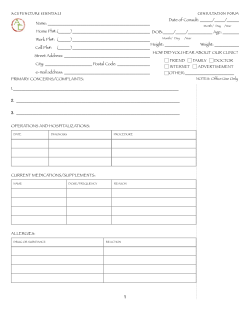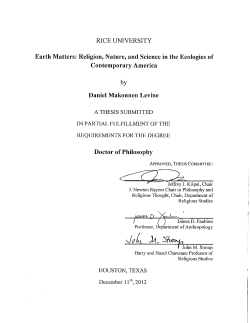
S ervice Designing and Managing Processes
CHAPTER 8 Designing and Managing Service Slide © by Lovelock, Wirtz and Chew 2009 Processes Essentials of Services Marketing Chapter 1 - Page 1 Flowcharting Service Delivery Helps to Clarify Product Elements Technique for displaying the nature and sequence of the different steps in service delivery to customers Offers way to understand total customer service experience Shows how nature of customer involvement with service organizations varies by type of service: People processing Possession processing Mental Stimulus processing Information processing Slide © by Lovelock, Wirtz and Chew 2009 Essentials of Services Marketing Chapter 1 - Page 2 Simple Flowchart for Delivery of a People-Processing Service Slide © by Lovelock, Wirtz and Chew 2009 Essentials of Services Marketing Chapter 1 - Page 3 Simple Flowchart for Delivery of a Possession-Processing Service Slide © by Lovelock, Wirtz and Chew 2009 Essentials of Services Marketing Chapter 1 - Page 4 Simple Flowchart for Delivery of a Mental Stimulus Processing Service Slide © by Lovelock, Wirtz and Chew 2009 Essentials of Services Marketing Chapter 1 - Page 5 Simple Flowchart for Delivery of an Information-Processing Service Slide © by Lovelock, Wirtz and Chew 2009 Essentials of Services Marketing Chapter 1 - Page 6 Blueprinting Developing a Blueprint Identify key activities in creating and delivering service Define “big picture” and “drill down” to obtain a higher level of detail Advantages of Blueprinting Distinguish between “frontstage” and “backstage” Clarify interactions between customers and staff, and support by backstage activities and systems Identify potential fail points; take preventive measures; prepare contingency Pinpoint stages in the process where customer commonly have to wait (wait points) Slide © by Lovelock, Wirtz and Chew 2009 Essentials of Services Marketing Chapter 1 - Page 7 Key Components of a Service Blueprint 1. Define standards for front-stage activities 2. Specify physical evidence 3. Identify main customer actions 4. Line of interaction (customers and front-stage personnel) 5. Frontstage actions by customer-contact personnel 6. Line of visibility (between front stage and backstage) 7. Backstage actions by customer contact personnel 8. Support processes involving other service personnel 9. Support processes involving IT - Identify fail points and risks of excessive waits - Failure-proofing and wait minimization/occupation Slide © by Lovelock, Wirtz and Chew 2009 Essentials of Services Marketing Chapter 1 - Page 8 Blueprinting The Restaurant Experience: A Three-Act Performance Act 1: Introductory Scenes Act 2: Delivery of Core Product Cocktails, seating, order food and wine, wine service Potential fail points: Menu information complete? Menu intelligible? Everything on the menu actually available? Mistakes in transmitting information a common cause of quality failure – e.g. bad handwriting; poor verbal communication Customers may not only evaluate quality of food and drink, but how promptly it is served, serving staff attitudes, or style of service Act 3: The Drama Concludes Check presented, customer pays, takes keys/coat and leaves Customer expectations: accurate, intelligible and prompt bill, payment handled politely, guests are thanked for their patronage Slide © by Lovelock, Wirtz and Chew 2009 Essentials of Services Marketing Chapter 1 - Page 9 Blueprinting the Restaurant Experience: Act 1 Slide © by Lovelock, Wirtz and Chew 2009 Essentials of Services Marketing Chapter 1 - Page 10 Improving Reliability of Processes by Failure Proofing Identify fail points Analysis of reasons for failure often reveals opportunities for failure proofing to reduce/eliminate future risk of errors Need fail-safe methods (poka-yokes) for both employees and customers Customer poka-yokes focus on preparing the customer for: The encounter Understanding and anticipating their roles Selecting the correct service or transaction Slide © by Lovelock, Wirtz and Chew 2009 Essentials of Services Marketing Chapter 1 - Page 11 Why Redesign? (1) “Institutions are like steel beams—they tend to rust. What was once smooth and shiny and nice tends to become rusty.” Mitchell T. Rabkin MD, formerly president of Boston’s Beth Israel Hospital Slide © by Lovelock, Wirtz and Chew 2009 Essentials of Services Marketing Chapter 1 - Page 12 Why Redesign? (2) Revitalizes process that has become outdated Changes in external environment make existing practices obsolete and require redesign of underlying processes Creation of brand-new processes to stay relevant Rusting occurs internally Natural deterioration of internal processes; creeping bureaucracy; evolution of spurious, unofficial standards Symptoms: - Extensive information exchange - Data that is not useful - High ratio of checking or control activities to value-adding activities - Increased exception processing - Customer complaints about inconvenient and unnecessary procedures Slide © by Lovelock, Wirtz and Chew 2009 Essentials of Services Marketing Chapter 1 - Page 13 Process Redesign: Approaches and Potential Benefits (1) Eliminating non-value-adding steps Simplify front-end and back-end processes with goal of focusing on benefit-producing part of service encounter Get rid of non-value adding steps Improve productivity and customer satisfaction Shifting to self-service Increase in productivity and service quality (sometimes!) Lower costs Enhance technology reputation Differentiates company Slide © by Lovelock, Wirtz and Chew 2009 Essentials of Services Marketing Chapter 1 - Page 14 Levels of Customer Participation (1) Customer Participation Actions and resources supplied by customers during service production and/or delivery Includes mental, physical, and even emotional inputs Slide © by Lovelock, Wirtz and Chew 2009 Essentials of Services Marketing Chapter 1 - Page 15 Levels of Customer Participation 3 levels Low – Employees and systems do all the work - Often involves standardized service - Examples: housecleaning by maid - Medium – Customer helps firm create and deliver service - Provides needed information and instructions - Make some personal effort; shares physical possessions - Examples: Massage treatment, hair cut High – Customer works actively with provider to co-produce the service - Service cannot be created without customer’s active participation - Customer can jeopardize quality of service outcome - Examples: weight loss, marriage counseling, education Slide © by Lovelock, Wirtz and Chew 2009 Essentials of Services Marketing Chapter 1 - Page 16 Customers as “Partial Employees” Customers can influence productivity and quality of service processes and outputs Customers need to have relevant service production competencies Customers with adequate skills need to be recruited For the relationship to last, both parties need to cooperate with each other Slide © by Lovelock, Wirtz and Chew 2009 Essentials of Services Marketing Chapter 1 - Page 17 Self-Service Technologies (SSTs) Ultimate form of customer involvement Customers undertake specific activities using facilities or systems provided by service supplier Customer’s time and effort replace those of employees - e.g. automated checkout, Internet-based services, ATMs, self-service gasoline pumps Challenge: getting customers to try this technology Slide © by Lovelock, Wirtz and Chew 2009 Essentials of Services Marketing Chapter 1 - Page 18 Psychological Factors Related to the use of SSTs SSTs advantages Time savings Cost savings Flexibility Convenience of location Greater control over service delivery High perceived level of customization SSTs disadvantages Anxiety and stress experienced by customers who are uncomfortable with using them Some see service encounters as social experiences and prefer to deal with people Slide © by Lovelock, Wirtz and Chew 2009 Essentials of Services Marketing Chapter 1 - Page 19 What Aspects Of SSTs Please Or Annoy Customers? People love SSTs when… SST machines are conveniently located and accessible 24/7—often as close as nearest computer! Obtaining detailed information and completing transactions can be done faster than through face-to-face or telephone contact People in awe of what technology can do for them when it works well People hate SSTs when… SSTs fail – system is down, PIN numbers not accepted, etc Poorly designed technologies that make service processes difficult to understand and use they mess up - forgetting passwords; failing to provide information as requested; simply hitting wrong buttons Slide © by Lovelock, Wirtz and Chew 2009 Essentials of Services Marketing Chapter 1 - Page 20 Putting SSTs to Test by Asking a Few Simple Questions Does the SST work reliably? Is the SST better than interpersonal alternatives? Firms must ensure that SSTs are dependable and userfriendly Customers will stick to conventional methods if SST doesn’t create benefits for them If it fails, what systems are in place to recover? Always provide systems, structures, and technologies that will enable prompt service recovery when things go wrong Slide © by Lovelock, Wirtz and Chew 2009 Essentials of Services Marketing Chapter 1 - Page 21
© Copyright 2025










